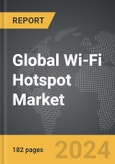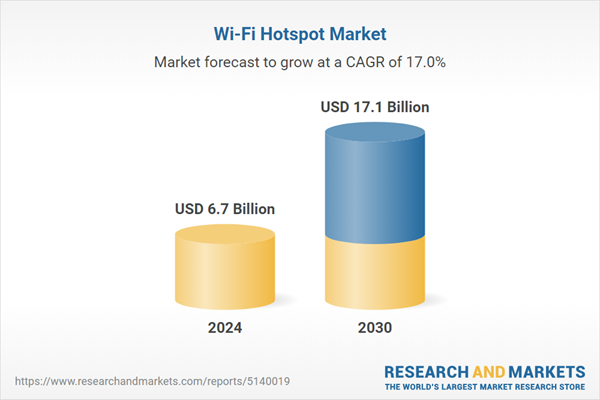The global market for Wi-Fi Hotspot was valued at US$6.7 Billion in 2024 and is projected to reach US$17.1 Billion by 2030, growing at a CAGR of 17.0% from 2024 to 2030. This comprehensive report provides an in-depth analysis of market trends, drivers, and forecasts, helping you make informed business decisions. The report includes the most recent global tariff developments and how they impact the Wi-Fi Hotspot market.
Segments: Solution (Hardware, Software, Services).
Geographic Regions/Countries: World; United States; Canada; Japan; China; Europe (France; Germany; Italy; United Kingdom; and Rest of Europe); Asia-Pacific; Rest of World.
The analysts continuously track trade developments worldwide, drawing insights from leading global economists and over 200 industry and policy institutions, including think tanks, trade organizations, and national economic advisory bodies. This intelligence is integrated into forecasting models to provide timely, data-driven analysis of emerging risks and opportunities.
Global Wi-Fi Hotspot Market - Key Trends & Drivers Summarized
Why Are Wi-Fi Hotspots Becoming More Crucial in the Age of Connectivity?
Wi-Fi hotspots are playing an increasingly vital role in today's connected world by providing reliable and high-speed internet access in public and private spaces, such as airports, cafes, hotels, educational institutions, and shopping malls. As more people rely on internet connectivity for work, education, social interaction, and entertainment, the demand for secure, fast, and accessible Wi-Fi hotspots continues to grow. These hotspots offer a cost-effective solution for extending network coverage and enhancing user experience in areas where traditional wired or cellular networks may be limited. The rise of remote working, digital learning, and on-the-go lifestyles is further driving the need for robust Wi-Fi hotspot networks that can support multiple users and devices simultaneously.What Technological Innovations Are Shaping the Future of Wi-Fi Hotspots?
Technological advancements in Wi-Fi standards, network management, and security are significantly shaping the future of Wi-Fi hotspots. The introduction of Wi-Fi 6 and 6E is revolutionizing hotspot performance by offering higher data throughput, increased capacity, and reduced latency, making them ideal for high-density environments such as stadiums, transportation hubs, and urban centers. The integration of cloud-based management platforms is enabling remote monitoring, automated updates, and real-time analytics, allowing service providers to optimize network performance and user experience. Additionally, innovations in hotspot 2.0 and seamless roaming technology are enabling automatic authentication and secure connections, providing users with a hassle-free and secure Wi-Fi experience as they move between different locations. These advancements are driving the adoption of Wi-Fi hotspots across various sectors, from hospitality and retail to education and healthcare.What Are the Challenges and Opportunities in the Wi-Fi Hotspot Market?
The Wi-Fi hotspot market faces several challenges, including network congestion, security vulnerabilities, and the need for continuous upgrades to meet evolving user expectations and technological standards. Additionally, the high cost of deploying and maintaining large-scale hotspot networks can be a barrier for some service providers. However, these challenges also present opportunities for growth and innovation. The increasing demand for seamless and secure Wi-Fi connectivity in public and private spaces is driving the need for advanced hotspot solutions that offer enhanced performance, security, and user experience. The development of managed Wi-Fi services, which provide end-to-end solutions for hotspot deployment, management, and support, is gaining traction among enterprises and small businesses. Moreover, the integration of Wi-Fi hotspots with emerging technologies such as 5G, IoT, and edge computing is creating new growth opportunities as businesses seek to leverage hybrid networks for improved connectivity and service delivery.What Is Driving the Growth of the Wi-Fi Hotspot Market?
The growth in the Wi-Fi Hotspot market is driven by several factors, including the rising demand for high-speed internet access in public and private spaces, increasing adoption of Wi-Fi 6 and 6E technologies, and technological advancements in hotspot management and security. The need for reliable and secure Wi-Fi connectivity in high-density environments such as airports, hotels, and urban centers is significantly boosting market demand for advanced hotspot solutions that can support multiple users and devices. Technological innovations in cloud-based management, seamless roaming, and hotspot 2.0 are enhancing the capabilities and user experience of Wi-Fi hotspots, making them more attractive to service providers and enterprises. The expansion of digital workplaces, remote learning, and smart city initiatives, coupled with the integration of Wi-Fi with 5G and IoT, is also driving market growth as stakeholders seek comprehensive connectivity solutions that offer flexibility, scalability, and performance.Report Scope
The report analyzes the Wi-Fi Hotspot market, presented in terms of units. The analysis covers the key segments and geographic regions outlined below.Segments: Solution (Hardware, Software, Services).
Geographic Regions/Countries: World; United States; Canada; Japan; China; Europe (France; Germany; Italy; United Kingdom; and Rest of Europe); Asia-Pacific; Rest of World.
Key Insights:
- Market Growth: Understand the significant growth trajectory of the Hardware segment, which is expected to reach US$8.5 Billion by 2030 with a CAGR of a 15.4%. The Software segment is also set to grow at 17.3% CAGR over the analysis period.
- Regional Analysis: Gain insights into the U.S. market, valued at $1.8 Billion in 2024, and China, forecasted to grow at an impressive 15.8% CAGR to reach $2.6 Billion by 2030. Discover growth trends in other key regions, including Japan, Canada, Germany, and the Asia-Pacific.
Why You Should Buy This Report:
- Detailed Market Analysis: Access a thorough analysis of the Global Wi-Fi Hotspot Market, covering all major geographic regions and market segments.
- Competitive Insights: Get an overview of the competitive landscape, including the market presence of major players across different geographies.
- Future Trends and Drivers: Understand the key trends and drivers shaping the future of the Global Wi-Fi Hotspot Market.
- Actionable Insights: Benefit from actionable insights that can help you identify new revenue opportunities and make strategic business decisions.
Key Questions Answered:
- How is the Global Wi-Fi Hotspot Market expected to evolve by 2030?
- What are the main drivers and restraints affecting the market?
- Which market segments will grow the most over the forecast period?
- How will market shares for different regions and segments change by 2030?
- Who are the leading players in the market, and what are their prospects?
Report Features:
- Comprehensive Market Data: Independent analysis of annual sales and market forecasts in US$ Million from 2024 to 2030.
- In-Depth Regional Analysis: Detailed insights into key markets, including the U.S., China, Japan, Canada, Europe, Asia-Pacific, Latin America, Middle East, and Africa.
- Company Profiles: Coverage of players such as Alcatel-Lucent SA, Aptilo Networks, Aruba Networks, Inc., Boingo Wireless, Inc., Cisco Systems, Inc. and more.
- Complimentary Updates: Receive free report updates for one year to keep you informed of the latest market developments.
Some of the 14 companies featured in this Wi-Fi Hotspot market report include:
- Alcatel-Lucent SA
- Aptilo Networks
- Aruba Networks, Inc.
- Boingo Wireless, Inc.
- Cisco Systems, Inc.
- Ericsson AB
- iPass Inc.
- NETGEAR, Inc.
- Nokia Networks
- Ruckus Wireless, Inc.
Tariff Impact Analysis: Key Insights for 2025
Global tariff negotiations across 180+ countries are reshaping supply chains, costs, and competitiveness. This report reflects the latest developments as of April 2025 and incorporates forward-looking insights into the market outlook.The analysts continuously track trade developments worldwide, drawing insights from leading global economists and over 200 industry and policy institutions, including think tanks, trade organizations, and national economic advisory bodies. This intelligence is integrated into forecasting models to provide timely, data-driven analysis of emerging risks and opportunities.
What’s Included in This Edition:
- Tariff-adjusted market forecasts by region and segment
- Analysis of cost and supply chain implications by sourcing and trade exposure
- Strategic insights into geographic shifts
Buyers receive a free July 2025 update with:
- Finalized tariff impacts and new trade agreement effects
- Updated projections reflecting global sourcing and cost shifts
- Expanded country-specific coverage across the industry
Table of Contents
I. METHODOLOGYII. EXECUTIVE SUMMARY2. FOCUS ON SELECT PLAYERSIII. MARKET ANALYSISIV. COMPETITION
1. MARKET OVERVIEW
3. MARKET TRENDS & DRIVERS
4. GLOBAL MARKET PERSPECTIVE
UNITED STATES
CANADA
JAPAN
CHINA
EUROPE
FRANCE
GERMANY
ITALY
UNITED KINGDOM
REST OF EUROPE
ASIA-PACIFIC
REST OF WORLD
Companies Mentioned (Partial List)
A selection of companies mentioned in this report includes, but is not limited to:
- Alcatel-Lucent SA
- Aptilo Networks
- Aruba Networks, Inc.
- Boingo Wireless, Inc.
- Cisco Systems, Inc.
- Ericsson AB
- iPass Inc.
- NETGEAR, Inc.
- Nokia Networks
- Ruckus Wireless, Inc.
Table Information
| Report Attribute | Details |
|---|---|
| No. of Pages | 182 |
| Published | April 2025 |
| Forecast Period | 2024 - 2030 |
| Estimated Market Value ( USD | $ 6.7 Billion |
| Forecasted Market Value ( USD | $ 17.1 Billion |
| Compound Annual Growth Rate | 17.0% |
| Regions Covered | Global |









